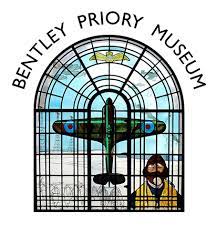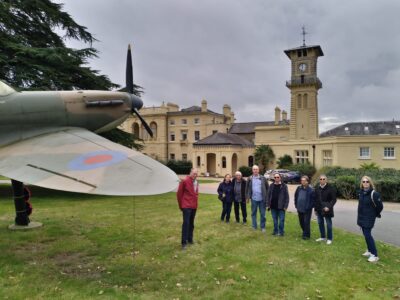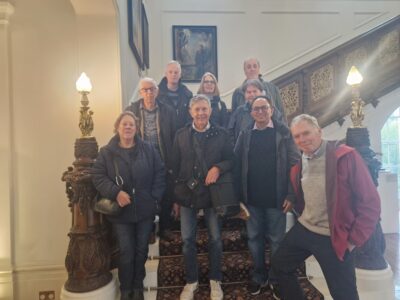 It was another lovely Saturday morning and we were looking forward with anticipation to visiting a place of huge National historical importance as our group set off on the journey to leafy Stanmore in North West London – arriving a couple of hours later at Bentley Priory Museum.
It was another lovely Saturday morning and we were looking forward with anticipation to visiting a place of huge National historical importance as our group set off on the journey to leafy Stanmore in North West London – arriving a couple of hours later at Bentley Priory Museum.
Bentley Priory is best known for its pivotal role as Headquarters Fighter Command during the battle of Britain in 1940.
After some refreshments we were given a tour by 2 very knowledgeable guides and we discovered that before the Air Ministry bought Bentley Priory in 1926, it had been a private home, hotel, and girls’ school.
 Then In 1926, the Priory estate was split up and one lot comprising of the Priory itself and around 40 acres was sold to the Air Ministry, for a sum believed to be £25,000, In May 1926.
Then In 1926, the Priory estate was split up and one lot comprising of the Priory itself and around 40 acres was sold to the Air Ministry, for a sum believed to be £25,000, In May 1926.
In July 1936, RAF Fighter Command was created and moved into Bentley, Air Chief Marshall Sir Hugh Dowding became its first Commander-in-Chief.
In later years Fighter Command amalgamated with Bomber Command in 1968, to form Strike Command and Bentley Priory became an administrative and training unit.
We learnt about the aerodynamics of 2 iconic fighter airplanes, the Supermarine Spitfire, and the Hawker Hurricane and then how radar was used so effectively and was one of the most important factors in the success of Britain’s air defences during the Battle of Britain.
Radar could be used to detect and locate incoming hostile aircraft. It worked by sending out radio waves which would bounce off solid objects at a distance, enabling operators to estimate four important things about approaching raids: the range (distance), bearing (direction), strength and height.
Radar was a crucial part of the ‘Dowding System’ Britain’s highly effective and sophisticated air defence network. This system allowed Royal Air Force (RAF) Fighter Command to respond to incoming hostile attacks and use its precious resources of pilots and aircraft to the best possible effect.
Radar gave early warning of approaching raids. This information filtered through Fighter Command HQ and was then communicated throughout the defence network. This gave fighter defences vital time to prepare for and intercept the attacks.
By the outbreak of the second World War in 1939, a chain of early warning radar stations, called Chain Home stations, had already been built along the South and East coasts of Britain.
Radar was not always accurate and didn’t produce a complete picture of the incoming threat – additional intelligence was provided by the Observer Corps. Its effectiveness also depended on the skills and judgment of the operators employed to interpret the signals.
In the Filter room our guides demonstrated how plotters would be continually updating the information coming in from Radar on to massive plotting maps of Britain – each small square on the map would signify 10 square miles, the plotters kept moving coloured discs and number blocks that would also include F for friendly or H for hostile.
 This information showed where all aircraft were situated at any given time – you could say that the plotters were early air traffic controllers, the plotters needed the upmost concentration and would only be allowed to work for 2 hours at any one time before needing a break.
This information showed where all aircraft were situated at any given time – you could say that the plotters were early air traffic controllers, the plotters needed the upmost concentration and would only be allowed to work for 2 hours at any one time before needing a break.
The information from the filter room was then sent to the control operations room who would alert each airfield with new instructions – the Dowding system was the World’s first ground- controlled communications system which was vital to Victory during the Battle of Britain.
We also toured the Rotunda room which commemorates the Battle of Britain aircrew and we watched a short film about Air Chief Marshall Hugh Dowding. Bentley Priory also has some lovely grounds outside including an Italian Garden.
We arrived back in Orpington early evening following an enjoyable and very interesting trip.
Article prepared by Dave Allen – October 2024


